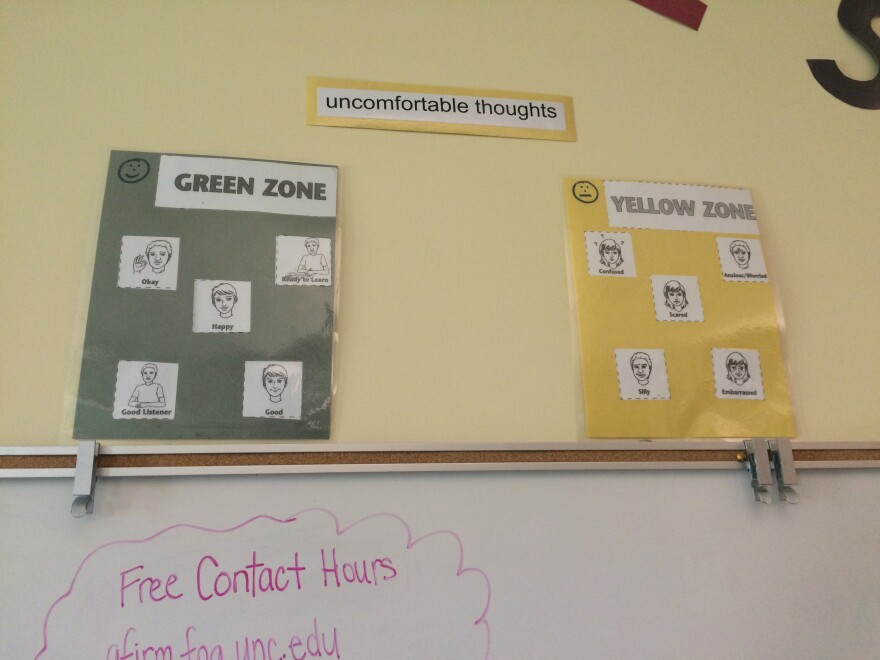School enrollment is declining in nearly all of Maine’s school districts. But in one city — Lewiston — more students keep pouring in each year.
In particular, the city is seeing a growth in students with disabilities, who require a lot of extra resources. Now, Lewiston is spending almost a quarter of its school budget on special ed programming, one of the highest rates in the state. The new influx of students has made Lewiston rethink its approach to special education.
Cherie LaFlamme, a behavioral analyst at Lewiston Public Schools, says there used to be a kind of secret among parents of children with disabilities in the area. Move to Lewiston, she says, and your child would likely get sent to a special private school.
“It was kind of an unspoken thing that everybody knew. That if you lived in Lewiston, your kids could go to a special-purpose school because Lewiston didn’t have the resources to support them,” she says.
At these special-purpose schools, like the Margaret Murphy Center for Children in Auburn, students get one-on-one teachers and individualized lesson plans that some public schools can’t offer. But for districts, there is a downside. They have to pay tuition to these schools, which can often be far more than what it would cost to keep a student in-district.
“It costs, for us, about $20,000-$30,000 per student. Where to service that student outside might be $50,000 or more,” says Bill Webster, Lewiston’s superintendent.
Webster says as the number of students with special needs has kept growing in Lewiston, the district has been forced to look inward and reconsider its special education strategy. Officials began to ask: Can Lewiston afford to keep sending these students out-of-district?
Lewiston also looked at federal disability laws, which say, if possible, a student should be placed in the “least restrictive environment.” That means with their peers, inside the district.
“But at the end of the day, we need to increasingly figure out: How can that student remain in the mainstream, or at least closer to the mainstream, with us still meeting that student’s needs and us meeting the needs of other students in the school?” Webster says.

Lewiston’s answer to all those questions is a new districtwide program called RISE, for students with severe disabilities. RISE launched two years ago, at two classrooms at Lewiston’s Geiger Elementary School.
The program requires a lot of resources: teachers, analysts, specialists and an individual education technician for every single student.
Inside Geiger Elementary, speech pathologist Brooke Ober works with one 6-year-old with autism who we’ll call Michael. Michael’s family didn’t want his full name used.
Ober says at the beginning of this year, Michael’s functional communication was almost nonexistent. He knew a few gestures, she says, like bouncing and spinning on a chair. But today, in a hallway outside of class, Ober is teaching Michael how to observe the world around him.
She lays out small jars of Play-Doh on the ground every ten feet or so. Then she and Michael zigzag along the tiles to find each jar.
“I see … blue … blue Play-Doh,” Michael says, holding a blob of putty in his hand.
“Nice work!” Ober encourages him. “Blue Play-Doh!”

“So this is actually pretty huge,” Ober says. “That’s he’s observing and finding these things. This is very new.”
Ober says she’s encouraged by how far Michael has come in just nine months in the RISE classroom. Now, she says, he identifies colors. He waves at other teachers passing by. And he even communicates by sticking words and phrases on a small Velcro pad.
Geiger Special Education Supervisor Michelle Winslow says this individualized attention is only one small part of why Lewiston wanted to create the RISE program. And she says what’s an even bigger deal is that these students are only a few feet away from their peers in general education classes. And when they’re ready, they can join them.
“That has shown to be very successful in getting students to be mainstreamed without the high level of support,” Winslow says, “and really transition them into general education as a whole.”
But the new shift hasn’t been easy. By this fall, the district plans to expand RISE to five classrooms covering kindergarten through 12th grade. In total, the district plans to add 45 new special education teachers just next year, which will increase the total school budget by more than 6 percent.
Webster says these programs will ultimately end up saving the town money, because it no longer has to pay to send as many students to special-purpose private schools. But it’s been a tough sell to Lewiston’s voters.
In May, less than 3 percent of the city population came out to vote, And they rejected the school budget by just six votes. Webster hopes that by the time the next budget vote comes around on June 14, the city will see a larger turnout and pass the larger budget.
But no matter what Lewiston ultimately decides, some in the district, like LaFlamme, are confident that these new programs are already transforming the city’s schools.
“I think if you look long-term, ten years, I really feel like what’s going to happen in Lewiston is there’s going to be a higher level of understanding and acceptance,” she says.
LaFlamme says that won’t just help students with disabilities. She thinks this culture shift will be just as important for the thousands of other Lewiston students, too.
By learning side-by-side with students with severe disabilities, she says, the experience will help to undo the stigma associated with special education.



